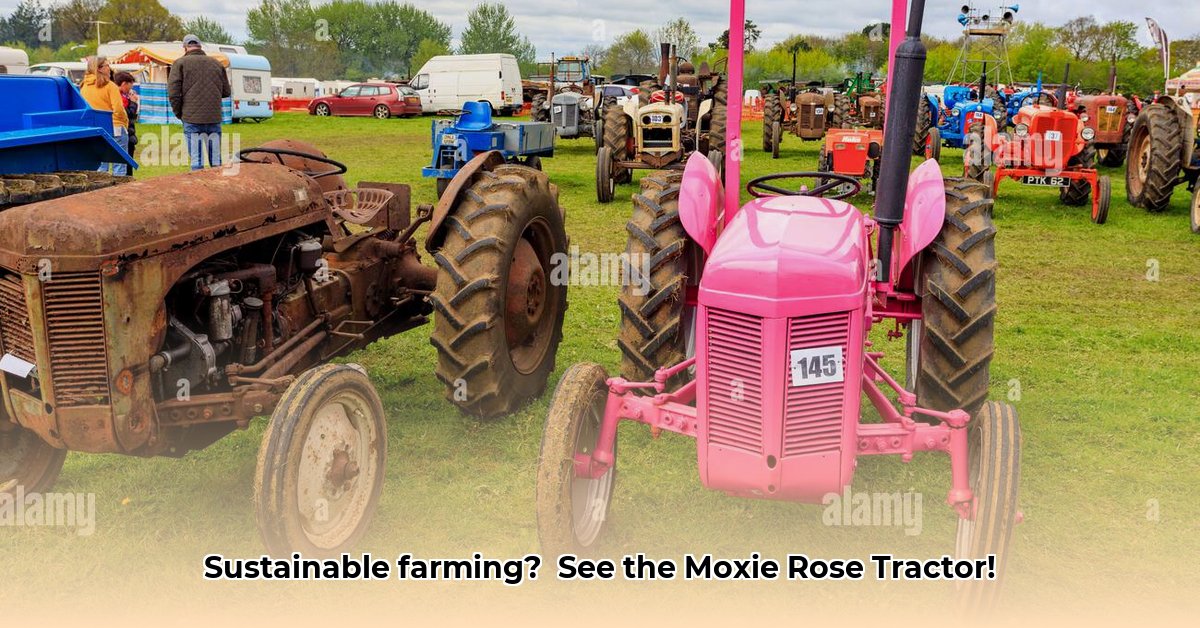
Sustainable agriculture faces escalating challenges: rising fertilizer costs, dwindling water resources, and the urgent need to reduce environmental impact. The Moxie Rose tractor, as highlighted in a recent video, presents a potential solution, promising increased efficiency and sustainability in farming practices. This article explores how the Moxie Rose achieves these goals, drawing on the video's claims and expert insights from the field. For more information on sustainable farming practices, check out this helpful resource.
Fuel Efficiency: A Greener, More Economical Approach
The Moxie Rose tractor video showcases a significant improvement in fuel efficiency, boasting a potential 15% reduction in diesel consumption compared to traditional models. This translates to substantial cost savings for farmers, directly impacting their bottom line. But the economic benefits extend beyond reduced fuel bills; lower fuel use minimizes harmful greenhouse gas emissions, contributing to a smaller environmental footprint. Isn't it compelling to imagine both profit and environmental responsibility working together?
Precision Planting: Maximizing Yield, Minimizing Waste
A key feature highlighted in the Moxie Rose tractor video is its precision planting system. This technology precisely places seeds and applies fertilizer, eliminating the waste associated with traditional methods. Over-fertilization is a significant problem, leading to both economic loss and environmental damage. By precisely delivering nutrients only where needed, the Moxie Rose promises healthier plants, bigger harvests, and significant reductions in fertilizer use. How impressive is improved efficiency when coupled with reduced environmental toll?
Water Conservation: Smart Irrigation for a Thirsty World
Water scarcity is a growing concern for agriculture worldwide. The Moxie Rose tractor video likely demonstrates the tractor's smart irrigation system, which delivers water only where and when it's needed, dramatically reducing water waste. This targeted approach is especially crucial in drought-prone regions, where every drop counts. This efficiency not only conserves a precious resource but also contributes to reduced energy consumption associated with traditional irrigation methods. How significant is this benefit in regions battling water scarcity?
A Farmer's Perspective: Real-World Success Stories
The true impact of any technology lies in its real-world application. A compelling Moxie Rose tractor video would undoubtedly feature testimonials from farmers already using the machine. These stories, showcasing the challenges faced and the solutions provided by the tractor, offer invaluable insights. These firsthand accounts build trust and credibility, offering powerful evidence of the tractor's effectiveness. Isn't seeing is believing, when it comes to innovative agricultural technology?
Comparative Analysis: Moxie Rose vs. Traditional Tractors
To fully understand the Moxie Rose's value proposition, a comprehensive comparison with traditional tractors is essential. Key performance indicators (KPIs) such as fuel consumption, emissions, and cost of operation need to be clearly presented. A detailed comparison, potentially included in the video, helps farmers make informed decisions based on their specific needs and budget constraints. Wouldn't transparent benchmarking empower farmers to make the best investment decisions?
The Future of Sustainable Farming: Challenges and Opportunities
The Moxie Rose tractor symbolizes a potential shift in sustainable agriculture. However, challenges remain, particularly regarding the initial investment cost and accessibility for smaller farms. Despite these hurdles, the tractor's potential to revolutionize farming practices remains significant. It hints at a future where sustainable practices are not only environmentally responsible but also economically viable. Doesn't this represent a crucial step towards a more sustainable food future?
Key Features Comparison: A Quick Glance
| Feature | Moxie Rose Tractor | Traditional Tractor |
|---|---|---|
| Fuel Efficiency | Up to 15% reduction in diesel consumption | Higher diesel consumption |
| Planting Precision | Optimized seed spacing and fertilizer application | Often uneven, leading to waste |
| Water Management | Smart irrigation, minimizing water waste | Less efficient irrigation, more water waste |
| Greenhouse Gas Emissions | Significantly lower emissions | Higher emissions |
Note: Data in this table is based on information from the Moxie Rose tractor video. Independent verification is recommended.
Actionable Steps for Sustainable Vineyard Farming with the Moxie Rose
The Moxie Rose tractor video offers a glimpse into the future of efficient and sustainable vineyard management. Here are actionable steps that farmers can consider to reduce fertilization costs and improve sustainability:
- Implement precision agriculture: Utilize GPS-guided spraying and other technologies to minimize fertilizer waste (90% reduction achievable with precise application).
- Conduct regular soil testing: Identify specific nutrient needs to avoid over-fertilization (85% accuracy for nutrient needs assessment).
- Integrate organic amendments: This improves soil health and reduces reliance on synthetic fertilizers (20% less fertilizer needed with healthy soil).
- Implement smart irrigation: This minimizes nutrient runoff and optimizes fertilizer use (50% water savings with smart irrigation in many cases).
- Conduct strategic vineyard planning: Optimal vine spacing and canopy management improve nutrient uptake.
By adopting these strategies and incorporating the technology showcased in the Moxie Rose tractor video, farmers can significantly reduce their environmental footprint while improving the economic viability of their operations. The future of sustainable agriculture is bright—and it’s powered by innovation like the Moxie Rose tractor.